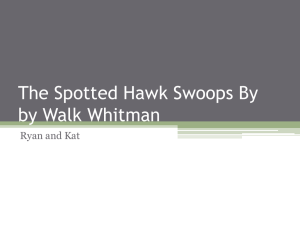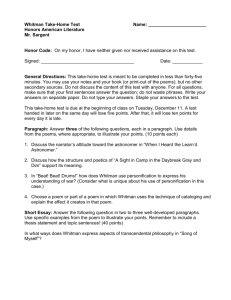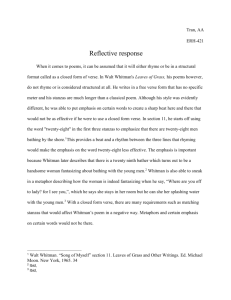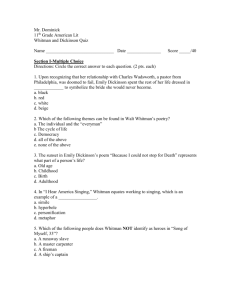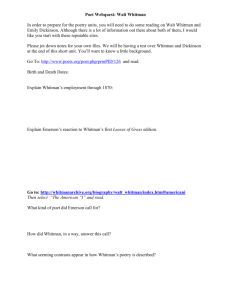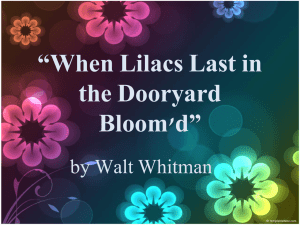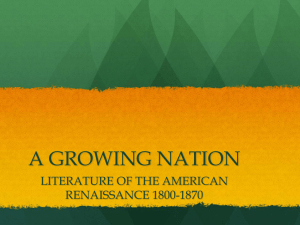SELECTED POETRY BY WALT WHITMAN
advertisement
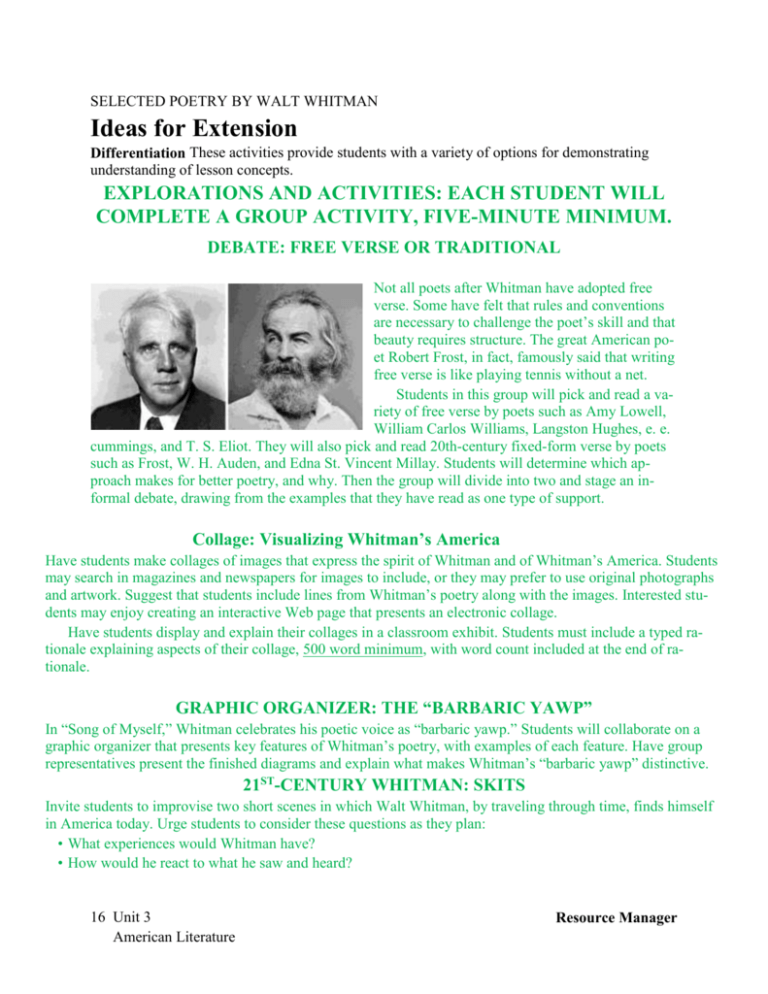
SELECTED POETRY BY WALT WHITMAN Ideas for Extension Differentiation These activities provide students with a variety of options for demonstrating understanding of lesson concepts. EXPLORATIONS AND ACTIVITIES: EACH STUDENT WILL COMPLETE A GROUP ACTIVITY, FIVE-MINUTE MINIMUM. DEBATE: FREE VERSE OR TRADITIONAL Not all poets after Whitman have adopted free verse. Some have felt that rules and conventions are necessary to challenge the poet’s skill and that beauty requires structure. The great American poet Robert Frost, in fact, famously said that writing free verse is like playing tennis without a net. Students in this group will pick and read a variety of free verse by poets such as Amy Lowell, William Carlos Williams, Langston Hughes, e. e. cummings, and T. S. Eliot. They will also pick and read 20th-century fixed-form verse by poets such as Frost, W. H. Auden, and Edna St. Vincent Millay. Students will determine which approach makes for better poetry, and why. Then the group will divide into two and stage an informal debate, drawing from the examples that they have read as one type of support. Collage: Visualizing Whitman’s America Have students make collages of images that express the spirit of Whitman and of Whitman’s America. Students may search in magazines and newspapers for images to include, or they may prefer to use original photographs and artwork. Suggest that students include lines from Whitman’s poetry along with the images. Interested students may enjoy creating an interactive Web page that presents an electronic collage. Have students display and explain their collages in a classroom exhibit. Students must include a typed rationale explaining aspects of their collage, 500 word minimum, with word count included at the end of rationale. GRAPHIC ORGANIZER: THE “BARBARIC YAWP” In “Song of Myself,” Whitman celebrates his poetic voice as “barbaric yawp.” Students will collaborate on a graphic organizer that presents key features of Whitman’s poetry, with examples of each feature. Have group representatives present the finished diagrams and explain what makes Whitman’s “barbaric yawp” distinctive. 21ST-CENTURY WHITMAN: SKITS Invite students to improvise two short scenes in which Walt Whitman, by traveling through time, finds himself in America today. Urge students to consider these questions as they plan: • What experiences would Whitman have? • How would he react to what he saw and heard? 16 Unit 3 American Literature Resource Manager • How would present-day Americans react to him? • Would his vision of America change as a result of his visit to America today? Why or why not? Students must include a typed rationale explaining aspects of their skits, 500 word minimum, with word count included at the end of rationale. INQUIRY AND RESEARCH: EACH STUDENT WILL CHOOSE ONE. WHITMAN’S CRITICAL RECEPTION: PANEL DISCUSSION What was the critical reception of Whitman early in his career and late in his career? How has he been received in our time? Have a group of students do research into old and newer reviews and critical articles about Whitman. To start, they should consult at least one biography of Whitman. Online research would provide additional examples of critical reviews. Early negative reviews might be especially interesting. Have students prepare and present a panel discussion in which they share their findings and read quotations from reviews to the class. BIBLICAL INFLUENCES ON WHITMAN’S POETRY: ORAL REPORT Have students inquire into the influence of biblical poetry upon Whitman’s free verse. The Book of Psalms is often noted as an influence because of its use of long lines, parallelism, and anaphora. Whitman’s metaphor in “Song of Myself,” comparing human beings to grass, echoes several biblical passages that make the same analogy. (See Isaiah 40:6 and 1 Peter 1:24, for example.) Have students draw conclusions about the biblical influences upon Whitman’s writing and report orally on their findings. WRITING: EACH STUDENT WILL CHOOSE ONE. MY OWN FREE VERSE: POEM Ask students to write two free-verse poems of their own, using Whitman’s poems as a model. Suggest these possible subjects: a) a modern-day “Song of Myself,” in which students express (in a way that they are willing to share) their sense of who they are and how they relate to the world; b) the character of America. Twelve lines for one poem, and 30 lines for the other poem. Poems will be typed. Students must include a typed rationale explaining aspects of their poems, 500 word minimum, with word count included at the end of rationale COMPARISON: EMERSON AND WHITMAN As noted on page 530, Ralph Waldo Emerson was one of Whitman’s earliest and most influential fans. Have students review the excerpts from Emerson’s essays Nature and Self-Reliance and imagine Whitman’s response to them. Have them also scan Whitman’s poems to find passages about nature and passages that express selfreliance. Ask students to think about the similarities and differences in the two writers’ views on those subjects. Then ask students to compose an essay comparing how the two writers share their ideas about nature and self-reliance. Encourage students to incorporate quotations from the writers’ works to support their ideas. Provide opportunities for students to share their papers with the class. Essay shall be 1200 word minimum, word count at end, typed, double-spaced, 12-point, Times New Roman, 1-inch margins. Any written info on essay, including name, is minus-ten points. Resource Manager Unit 3 American Literature 17
